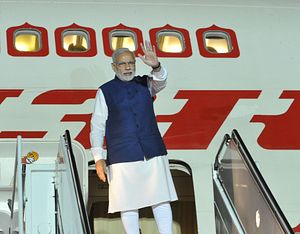The Indian prime minister, Narendra Modi, just concluded a fairly eventful visit to the United States. At the annual United Nations General Assembly (UNGA) in New York, Modi spoke of his government’s focus on a wide range of issues, from economic growth and climate change, to poverty alleviation, energy security and sustainable development. In his UNGA address, delivered on Friday, September 25, at the UN’s Sustainable Development Summit, Modi also pitched for Security Council reforms, the prospects for which, however dim, received a shot in the arm as a result of the Kutesa Consensus earlier in September.
Before heading back to New Delhi, Modi also met with President Obama and the two leaders discussed climate change, clean energy, trade and investment, and regional security.
But what Modi chose to do in between his New York engagements — the UNGA address on the 26th and his meeting with Obama on the 29th – makes his second visit to the U.S. since assuming office even more significant. He traveled to California, meeting with business leaders of the state’s high-tech industry in Silicon Valley and delivered a speech to a near-capacity crowd of (mostly) Indian-Americans at the SAP Center in San Jose.
In so doing, Modi became the first Indian Prime Minister to visit California in 33 years. This is an astounding statistic for a country whose economy and technology sectors are so integrated with Silicon Valley’s technology industries. Indeed, India’s own high-tech hub of Bangalore – home to many Indian and international technology companies, including those from the Bay Area — prides itself as the “Silicon Valley of India.”
For the better part of two decades, Indian prime ministerial visits to the U.S. — with the exception of a short trip by Manmohan Singh to Pittsburg for a G-20 summit in 2009 — have been one-stop or two-stop affairs centered around Washington, D.C. and New York. Of course, this was not always the case. For example, on his first visit to the U.S. as an Indian Prime Minister in 1949, Jawaharlal Nehru visited Chicago, San Francisco and Madison, Wisconsin, in addition to New York.
Moraji Desai too traveled west, to Omaha and San Francisco during his 1978 visit, while Indira Gandhi visited Los Angeles and Honolulu in her first official visit to the U.S. since returning to power in 1980. Since then, however, there has been a paucity of imagination in Indian diplomacy and a lack of appreciation of the value of travel beyond the Beltway and New York to attract American businesses to India.
California today exports more to India ($5.3 billion) than any other U.S. state (over twice that of its nearest competitor, New York) and accounts for nearly a quarter of the U.S.’s total exports to India. Exports from California to India have also grown substantially, in relative terms, by 59 percent since 2010. Three of the top five counties in the U.S. with Indian immigrants are located in California (Santa Clara, Alameda and Los Angeles), and in aggregate, California has more Indian immigrants than any other U.S. state. Narendra Modi’s visit out west appears to be a recognition of the importance of the Golden State to India’s economic growth and prosperity.
Modi has proven himself to be the consummate salesman. If his first visit to the U.S. last year was to repair a moribund India-U.S. relationship and sell Obama and the Washington elite on an India open to investment and less reticent on cooperation, particularly as it relates to Asia’s security architecture, his visit this time around was to attract high-tech companies to invest in India and partner with the government on its key technology initiatives.
His visits to the headquarters of Google and Facebook were aimed at eliciting support for his government’s “Digital India” campaign, which aims to provide government services to citizens electronically through improved technology infrastructure and Internet connectivity. Modi left with commitments from Facebook CEO Mark Zuckerberg to build WiFi hotspots in rural India and from Google to provide broadband connectivity to India’s railway stations.
In San Jose, Modi was on familiar ground. Engaging with Indian diaspora has been a recurring theme in Modi’s foreign visits. He enthralled a crowd of about 18,000 (which included California and DC political leaders: Bay Area mayors, House Minority Leader Nancy Pelosi and Rep. Mike Honda, among others) with rhetorical flourish, making a pitch for his financial inclusion program, and underscoring the historical links between India and California.
For now, Modi appears to have sold Silicon Valley’s technology heavyweights on his government’s vision for India. But challenges back home continue to linger. Key reform initiatives of the Modi government, including land amendments and the Goods and Services Tax (GST) bill aimed at improving the country’s investment climate, have floundered. In many ways, selling investors of his vision for India, though crucial, was the easy bit. Delivering on promises made to investors and to India’s citizens who delivered a decisive mandate for him last May will be a much more challenging prospect.

































